The biggest hurdle for renewable energy today is storage. How to store the excess unconsumed energy produced for use during intermittent disruptions or at night in the case of solar energy.
This is not only an issue for the renewable energy industry — the entire energy sector faces the same problem. The use of coal to produce energy, does so at a relatively fixed rate over time even though demand for electricity can fluctuate throughout the day. There is the need to develop effective energy storage technology capable of storing electrical energy so it can be available to meet peak demand periods.
This not only helps reduce the cost utilities charge customers at peak usage times of the day; but it will help make renewable energy, whose power output cannot be controlled by grid operators, smooth and dispatchable. This will definitely solve the long-running issue of how to effectively balance the mix between generation and load.
“Better ways of storing energy are needed if electricity systems are to become cleaner and more efficient
— The Economist
Although there are many conventional energy storage applications worldwide, flywheel technologies are making significant headway.
If history has taught us one thing about energy storage, it is that spinning wheels have been used to store energy for centuries. You may be aware or remember that this is the same working principle used in potter’s wheels where energy in the disk helps maintain a consistent velocity.
Flywheel technology has also been a major component of steam engines converting energy from pistons into consistent rotational motion. I can go on and on but only recently have large cylindrical flywheels been used to quickly store and release electric power, as a way to keep complex power grids in balance.
At the fore front of using the flywheel technology for energy storage, is Temporal Power, a Canadian company of humble beginnings which creates high performance energy storage systems for grid stabilization and energy balancing usage. Temporal Power works closely with Effective Technical Solutions Group Inc. (ETSG); a leading solutions based firm in new power delivery technologies to help drive much of the interest and is the largest proponent of the use of this technology in both renewables and nontraditional power delivery markets.
Visiting Temporal Power:
Temporal Power is located in Mississauga about 28 KM Southeast of Toronto in the province of Ontario, Canada. The company designs, manufactures and services the world’s leading flywheel energy storage technology. Using an all steel flywheel in combination with proprietary bearing technology, the company offers a high-performance energy storage solution that holds the highest amount of energy of any flywheel in the world, offers no degradation due to cycle life, and is a clean technology made of fully recyclable materials.
I recently visited the company’s facility in Mississauga. Upon entering the facility, I was received by Mr. Jeffrey Veltri — the inventor of Temporal Power’s flywheel system — who is also the President and CTO. He was accompanied by Mr. Andy Garbas the Founder of Effective Technical Solutions Group (ETSG) which explores applications involving the use of this incredible energy storage system to revolutionize the power delivery market.
After introductions we jumped right into the tour of the facility. I couldn’t help but notice a heightened sense of safety measures implemented throughout the “visitors tour” of the office space as well as the mechanical and electrical spaces. This made me feel very safe and comfortable even though surrounded by heavy machinery and equipment.
The Technology
I consider Jeff as the “Steve Jobs” of the energy storage industry. By re-inventing the flywheel technology for usage in energy storage, makes it easy to integrate variable power generated from renewable sources like solar into the grid. He completely removed chemistry from the equation, removing extremely dangerous and expensive acids or chemicals to introducing a simple yet tactical technology that has been proven to work throughout history.
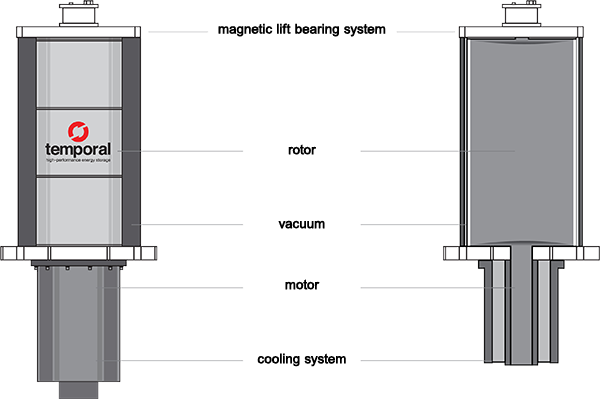 A cross section schematic of the Temporal Power flywheel showing different parts and components.
A cross section schematic of the Temporal Power flywheel showing different parts and components.
His patented design of the flywheel gives these 4,000-kilogram solid-steel structures the ability to hold massive amounts of energy many hundred times greater than conventional (smaller) flywheels with a 20-year life cycle, 100% recyclable and with ease of maintenance.
“I’m a very practical-hands-on engineer,” said Jeff as he showed me the prototypes of the flywheels he made about 6 years ago. “I wanted to store energy when it is inexpensive and then use it again when it is expensive. So I started working on this idea from my garage.”
“Get it? Garage + revolutionary idea? That makes me think of Steve Jobs!
— Derick Ajumni, Founder and Editorial Manager at PVBuzz
 Mr. Jeffrey Veltri, President and CTO of Temporal Power Ltd. Image Credit: Derick Ajumni of PVBuzz
Mr. Jeffrey Veltri, President and CTO of Temporal Power Ltd. Image Credit: Derick Ajumni of PVBuzz
Why the flywheel technology?
“Well, I looked at different storage technologies, batteries, capacitors, and flywheels. But I gravitated towards flywheels because unlike batteries, flywheels can be charged and discharged thousands of times without any detriment to the device. Whereas with batteries, after several thousands of full charge/discharge cycles — you will have to replace the cells,” Jeff explains.
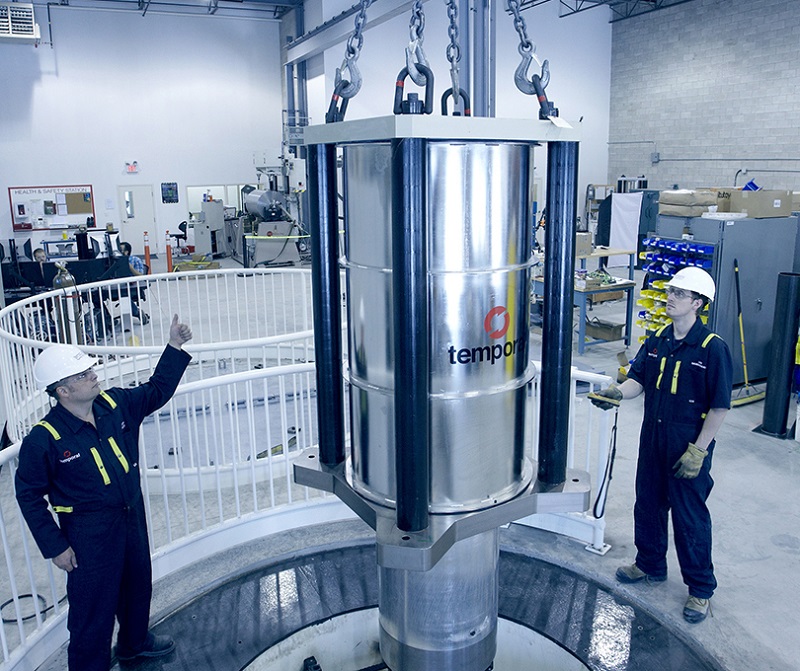 Two Temporal Power engineers lower Flywheel into the concrete vault. Image Credit: Temporal Power
Two Temporal Power engineers lower Flywheel into the concrete vault. Image Credit: Temporal Power
“Another point to note is that in a battery system you are limited to about 30% usage of a certain rated capacity because fully charging and discharging them isn’t recommended. So you may end up buying a lot more batteries than you actually need,” said Andy Garbas. “In the flywheel system, you can essentially charge and discharge an unlimited number of times due to its design taking advantage of its full energy capacity (100%),” continued Andy.
In Temporal Power’s Flywheel design, an electric machine which can operate as an induction motor or generator is directly coupled to a solid steel cylinder that runs inside a vacuum contaminant with upper and lower mechanical bearings that position the flywheel. Jeff notes that the unique thing about their technology is the use of a permanent fixed magnet (similar to a fridge magnet) to levitate all of the rotor mass off the bearings.
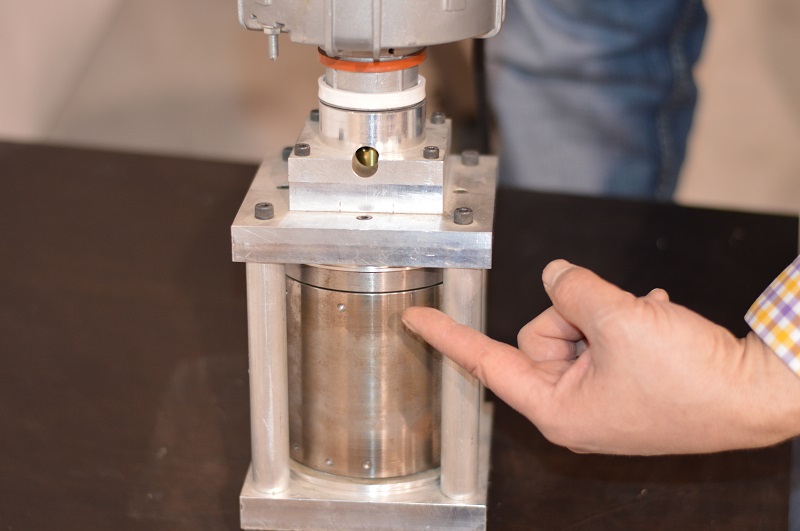 Jeff points at a unique feature on Temporal Power’s prototype which is a visible gap between the magnetic lift system and the rotor. Image Credit: Derick Ajumni of PVBuzz.
Jeff points at a unique feature on Temporal Power’s prototype which is a visible gap between the magnetic lift system and the rotor. Image Credit: Derick Ajumni of PVBuzz.
This magnet material is strong, can be bent, die cut and assembled in different shapes and sizes. The magnet forms magnetic flux or magnetic flow lines that run back into the steel lifting all of the rotor weight without touching it. Evidenced by a visible gap between the magnetic lift system and the rotor (above image).
“This creates a permanent magnetic life system that requires zero electrical energy. Unlike most flywheels used today that require some sort of electrical lift system, ours doesn’t!
— Mr. Jeffrey Veltri, President, and CTO of Temporal Power Ltd., as well as the inventor of Temporal Power’s proprietary flywheel system.
How does this thing work?
Andy Garbas explained that the flywheel works by charge and discharge. Charging the machine involves taking electrical energy off the grid and running it through a variable frequency drive such as an inverter that basically changes the frequency from 0 to hundreds of Hertz. The motor converts electric power to the mechanical momentum of the rotor, and the rotor speeds up. At some point in the future when a command comes to discharge the machine, the motor switches to become a generator, as the slowing rotor transfers its energy back into electricity.
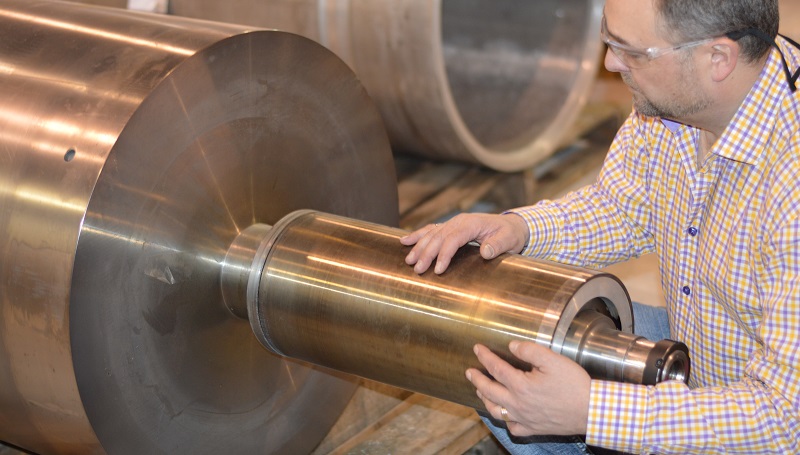 Jeff Veltri examines one of the many Flywheel steel motors on the facility floor. Image Credit: Derick Ajumni of PVBuzz.
Jeff Veltri examines one of the many Flywheel steel motors on the facility floor. Image Credit: Derick Ajumni of PVBuzz.
Andy added that the concept is simple; by accelerating the machine you charge it, and by decelerating the machine you discharge it.
“The beauty with flywheels is that this can be done in milliseconds. So one can go from full output power to full input power in about 50 to 100 milliseconds all day long, 24/7, 365 days a year without any detriment to the machine,” said Andy.
Andy also continued to explain that only Temporal Power makes the largest commercially available flywheels in the world rated at 50kWh (equal to 3 Chevy volts) which can push and pull power up to 500kW for 6 minutes. To put it in perspective, most flywheels are rated at about 1kWh. Comparatively, at 1KWH most others can only provide 5-15 seconds of stored energy compared to Temporal’s Minutes.
“What I succeeded in doing is design a flywheel that stores energy for hours at a time; something no one else has ever done before,” said Jeff.
Temporal Power’s flywheels have been installed and are actively being used in Ontario, Canada. One of such an installation is at NRStor’s facility under contract with the IESO for frequency stability, and there are also other plans in the works for a wind energy facility in Tillsonburg for Hydro One.
“The idea and initial intent for creating this technology is for grid stability,” said Andy. “This solves the problem of the distributed generation where you have different green energy generation mechanisms lending to the grid that is not as constant as traditional mechanisms of energy generation.
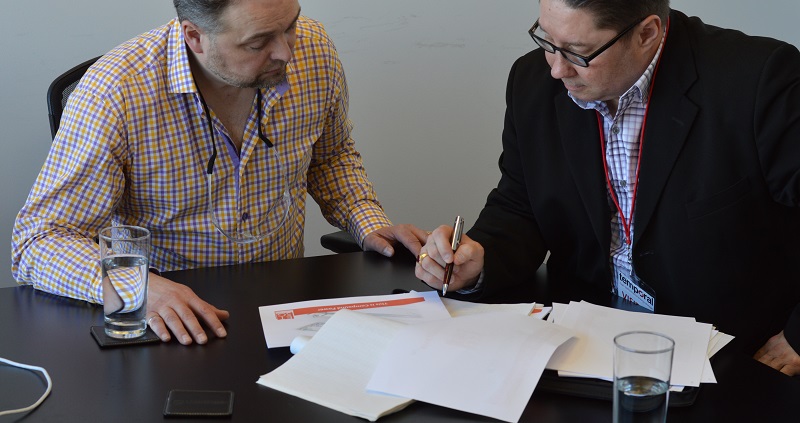 Mr. Jeffrey Veltri and Mr. Andy Garbas review strategic initiatives. Image Credit: Derick Ajumni of PVBuzz.
Mr. Jeffrey Veltri and Mr. Andy Garbas review strategic initiatives. Image Credit: Derick Ajumni of PVBuzz.
An awesome thing to note about effective storage technology is the frequency regulation it can provide to help maintain the balance between the network’s load and power generated, supplying reliable power for high tech industrial facilities. That said, it becomes easy to understand why a good and effective energy storage technology will play a substantial role in transforming the electric power industry.
“There is a lot of talk about energy storage, storing it now to use later, but where energy storage has the most value in our eyes is in high-speed precision voltage and frequency regulation,” Veltri says. “This saves money, allows green energy to be integrated into the grid and can save island nations enormously in diesel fuel costs. We hope to have our technology used on islands in the near future.
— Mr. Jeffrey Veltri, President and CTO of Temporal Power talking to Design-Engineering.
It is important to understand how the energy storage industry will grow and change over the next few years. This will help renewable energy industries understand how and when storage will contribute to the renewables sector. Navigant Research stated in its Energy Storage Tracker 3Q14 that this is a critical time for the advanced energy storage industry, that in order for the industry to continue to scale, more systems integrators are needed.
“The energy storage market is real, rapidly expanding, and of critical importance to utilities and players across the renewable energy industry.
— Scott Clavenna, CEO and Co-Founder of GreenTechMedia
This flywheel technology aims to end the renewable energy/utility gridlock. The energy storage machine will make variable generation more predictable for smooth power grid integration — helping electric system operators efficiently balance energy to control frequency.




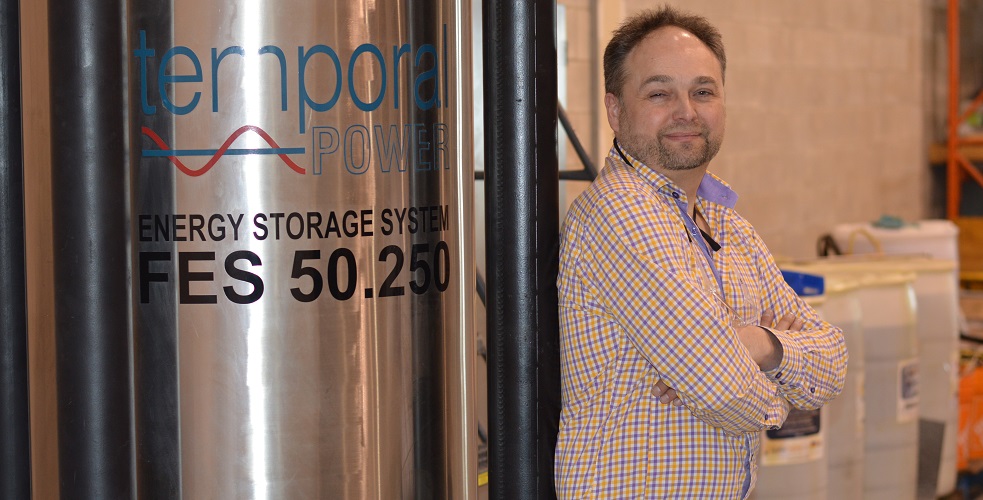










Comments